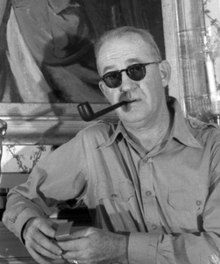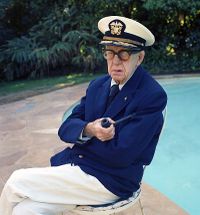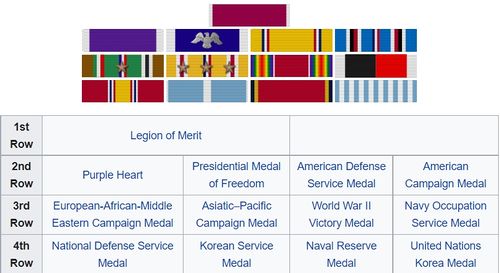John Ford
John Martin Feeney (February 1, 1894 – August 31, 1973), known professionally as John Ford, was an American film director and naval officer. He is renowned both for Westerns such as Stagecoach (1939), The Searchers (1956), and The Man Who Shot Liberty Valance (1962), as well as adaptations of classic 20th century American novels such as The Grapes of Wrath (1940). He was the recipient of six Academy Awards including a record four wins for Best Director.
In a career of more than 50 years, Ford directed more than 140 films (although most of his silent films are now lost) and he is widely regarded as one of the most important and influential filmmakers of his generation. Ford's work was held in high regard by his colleagues, with Orson Welles and Ingmar Bergman among those who named him one of the greatest directors of all time.
Ford made frequent use of location shooting and wide shots, in which his characters were framed against a vast, harsh, and rugged natural terrain.
Early life
Ford was born John Martin "Jack" Feeney (though he later often gave his given names as Seán Aloysius, sometimes with surname O'Feeny or Ó Fearna; an Irish language equivalent of Feeney) in Cape Elizabeth, Maine, to John Augustine Feeney and Barbara "Abbey" Curran, on February 1, 1894, (though he occasionally said 1895 and that date is erroneously inscribed on his tombstone). His father, John Augustine, was born in Spiddal, County Galway, Ireland, in 1854. Barbara Curran was born in the Islands, in the town of Kilronan on the island of Inishmore (Inis Mór). John A. Feeney's grandmother, Barbara Morris, was said to be a member of an impoverished branch of a family of the Irish nobility, the Morrises of Spiddal (headed at present by Lord Killanin).
John Augustine and Barbara Curran arrived in Boston and Portland respectively in May and June 1872. They filed their intentions to marry on July 31, 1875, and became American citizens five years later on September 11, 1880. The John Augustine Feeney family resided on Sheridan Street, in the Irish neighborhood of Munjoy Hill in Portland, Maine, and his father worked a variety of odd jobs to support the family – farming, fishing, a laborer for the gas company, saloon keeping, and an alderman. John and Barbara had eleven children: Mamie (Mary Agnes), born 1876; Delia (Edith), 1878–1881; Patrick; Francis Ford, 1881–1953; Bridget, 1883–1884; Barbara, born and died 1888; Edward, born 1889; Josephine, born 1891; Hannah (Joanna), born and died 1892; John Martin, 1894–1973; and Daniel, born and died 1896 (or 1898).
War years
During World War II, Ford served as head of the photographic unit for the Office of Strategic Services[Note 1] and made documentaries for the Navy Department. He was commissioned as a commander in the United States Navy Reserve. He won two more Academy Awards during this time, one for the semi-documentary The Battle of Midway (1942), and one for the propaganda film December 7th: The Movie (1943). Ford filmed the Japanese attack on Midway from the power plant of Sand Island and was wounded in the arm.
Ford was also present on Omaha Beach on D-Day. He crossed the English Channel on the USS Plunkett (DD-431), which anchored off Omaha Beach at 0600. He observed the first wave land on the beach from the ship, landing on the beach himself later with a team of Coast Guard cameramen who filmed the battle from behind the beach obstacles, with Ford directing operations. The film was edited in London, but very little was released to the public. Ford explained in a 1964 interview that the US Government was "afraid to show so many American casualties on the screen", adding that all of the D-Day film "still exists in color in storage in Anacostia near Washington, D.C." Thirty years later, historian Stephen E. Ambrose reported that the Eisenhower Center had been unable to find the film. Ford eventually rose to become a top adviser to OSS head William Joseph Donovan[Note 2]. According to records released in 2008, Ford was cited by his superiors for bravery, taking a position to film one mission that was "an obvious and clear target". He survived "continuous attack and was wounded" while he continued filming, one commendation in his file states. In 1945, Ford executed affidavits testifying to the integrity of films taken to document conditions at Nazi concentration camps.
His last wartime film was They Were Expendable (MGM, 1945) with John Wayne and Robert Montgomery, an account of America's disastrous defeat in The Philippines, told from the viewpoint of a PT boat squadron and its commander. Ford created a part for the recovering Ward Bond, who needed money. Although he was seen throughout the movie, he never walked until they put in a part where he was shot in the leg. For the rest of the picture, he was able to use a crutch on the final march. Ford repeatedly declared that he disliked the film and had never watched it, complaining that he had been forced to make it, although it was strongly championed by filmmaker Lindsay Anderson. Released several months after the end of the war, it was among the year's top 20 box-office draws, although Tag Gallagher notes that many critics have incorrectly claimed that it lost money.
Post-war career
After the war, Ford remained an officer in the United States Navy Reserve. He returned to active service during the Korean War and was promoted to Rear Admiral the day he left service.
Ford directed sixteen features and several documentaries in the decade between 1946 and 1956. As with his pre-war career, his films alternated between (relative) box office flops and major successes, but most of his later films made a solid profit, and Fort Apache, The Quiet Man, Mogambo, and The Searchers all ranked in the Top 20 box-office hits of their respective years.
Ford's first postwar movie My Darling Clementine (Fox, 1946) was a romanticized retelling of the primal Western legend of Wyatt Earp and the Gunfight at the O.K. Corral, with exterior sequences filmed on location in the visually spectacular (but geographically inappropriate) Monument Valley. It reunited Ford with Henry Fonda (as Earp) and co-starred Victor Mature in one of his best roles as the consumptive, Shakespeare-loving Doc Holliday, with Ward Bond and Tim Holt as the Earp brothers, Linda Darnell as sultry saloon girl Chihuahua, a strong performance by Walter Brennan (in a rare villainous role) as the venomous Old Man Clanton, with Jane Darwell and an early screen appearance by John Ireland as Billy Clanton. In contrast to the string of successes in 1939–1941, it won no major American awards, although it was awarded a silver ribbon for Best Foreign Film in 1948 by the Italian National Syndicate of Film Journalists, and it was a solid financial success, grossing $2.75 million in the United States and $1.75 million internationally in its first year of release.
A Personal Note from Robin
Growing up, John Ford made almost all the movies I watched. John Wayne starred in most of them.
The WikiPedia article has a lot of information about Ford but presents it as a narrative instead of history.
Ford was there at the battle of Midway, the landing on Normandy, etc. He headed up the OSS before the Washington DC politicians morphed it into the CIA.
Notes
- ↑ OSS was dissolved a month after the end of the war. Intelligence tasks were shortly later resumed and carried over by its successors the Department of State's Bureau of Intelligence and Research (INR), and the Central Intelligence Agency
- ↑ Also known as "Wild Bill Donovan", who headed up CIA after WWII
- Wikipedia article: John Ford
| Note: John Ford was a volunteer at the Hollywood Canteen |
Chat rooms • What links here • Copyright info • Contact information • Category:Root


